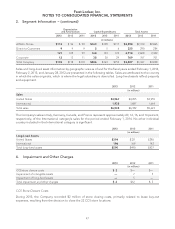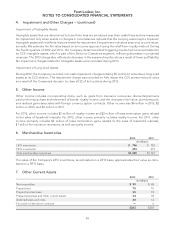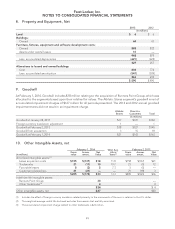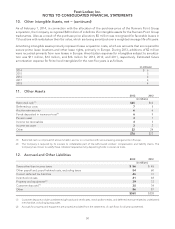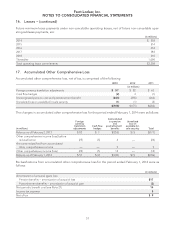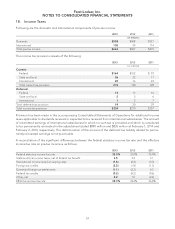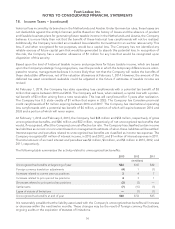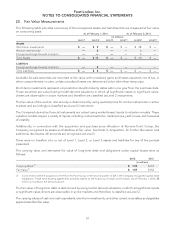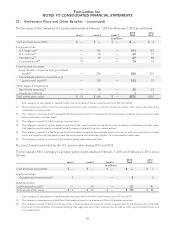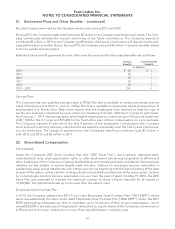Foot Locker 2013 Annual Report Download - page 80
Download and view the complete annual report
Please find page 80 of the 2013 Foot Locker annual report below. You can navigate through the pages in the report by either clicking on the pages listed below, or by using the keyword search tool below to find specific information within the annual report.Foot Locker, Inc.
NOTES TO CONSOLIDATED FINANCIAL STATEMENTS
18. Income Taxes − (continued)
Settlements could increase earnings in an amount ranging from $0 to $5 million based on current estimates.
Audit outcomes and the timing of audit settlements are subject to significant uncertainty. Although manage-
ment believes that adequate provision has been made for such issues, the ultimate resolution could have an
adverse effect on the earnings of the Company. Conversely, if these issues are resolved favorably in the future,
the related provision would be reduced, generating a positive effect on earnings. Due to the uncertainty of
amounts and in accordance with its accounting policies, the Company has not recorded any potential impact
of these settlements.
19. Financial Instruments and Risk Management
The Company operates internationally and utilizes certain derivative financial instruments to mitigate its foreign
currency exposures, primarily related to third-party and intercompany forecasted transactions. As a result of the
use of derivative instruments, the Company is exposed to the risk that counterparties will fail to meet their
contractual obligations. To mitigate this counterparty credit risk, the Company has a practice of entering into
contracts only with major financial institutions selected based upon their credit ratings and other financial
factors. The Company monitors the creditworthiness of counterparties throughout the duration of the deriva-
tive instrument. Additional information is contained within Note 20, Fair Value Measurements.
Derivative Holdings Designated as Hedges
For a derivative to qualify as a hedge at inception and throughout the hedged period, the Company formally
documents the nature of the hedged items and the relationships between the hedging instruments and the
hedged items, as well as its risk-management objectives, strategies for undertaking the various hedge transac-
tions, and the methods of assessing hedge effectiveness and ineffectiveness. In addition, for hedges of
forecasted transactions, the significant characteristics and expected terms of a forecasted transaction must be
specifically identified, and it must be probable that each forecasted transaction would occur. If it were deemed
probable that the forecasted transaction would not occur, the gain or loss on the derivative instrument would
be recognized in earnings immediately. No such gains or losses were recognized in earnings for any of the
periods presented. Derivative financial instruments qualifying for hedge accounting must maintain a specified
level of effectiveness between the hedging instrument and the item being hedged, both at inception and
throughout the hedged period, which management evaluates periodically.
The primary currencies to which the Company is exposed are the euro, British pound, Canadian dollar, and
Australian dollar. For option and foreign exchange forward contracts designated as cash flow hedges of the
purchase of inventory, the effective portion of gains and losses is deferred as a component of Accumulated
Other Comprehensive Loss (‘‘AOCL’’) and is recognized as a component of cost of sales when the related
inventory is sold. The amount reclassified to cost of sales related to such contracts was not significant for any of
the periods presented. The effective portion of gains or losses associated with other forward contracts is
deferred as a component of AOCL until the underlying transaction is reported in earnings. The ineffective
portion of gains and losses related to cash flow hedges recorded to earnings was also not significant for any of
the periods presented. When using a forward contract as a hedging instrument, the Company excludes the
time value of the contract from the assessment of effectiveness. For all years presented, the Company had not
hedged forecasted transactions for more than the next twelve months, and the Company expects all derivative-
related amounts reported in AOCL to be reclassified to earnings within twelve months. During 2013, the net
change in the fair value of the foreign exchange derivative financial instruments designated as cash flow hedges
of the purchase of inventory resulted in a loss of $5 million and therefore increased AOCL. At February 1, 2014
there was a $2 million loss included in AOCL.
The notional value of the contracts outstanding at February 1, 2014 was $70 million and these contracts extend
through January 2015.
57


